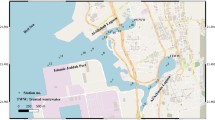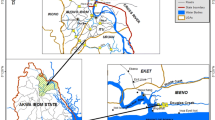Abstract
This study investigated the presence of 16 priority polycyclic aromatic compounds (PAHs) in waters from the Douro River estuary and nearby Atlantic seacoast, which both bath the Porto metropolis. In the area, there is an oil refinery, an important harbour, an intense maritime traffic, small marinas and highly inhabited cities. For the analysis of PAHs, water samples were taken from four sampling sites, at six different times of the year (2011), and extracted by solid-phase extraction (dissolved fraction) and by ultrasound technique (suspended fraction), before their quantification by gas chromatography–mass spectrometry. Results not only proved the ubiquitous distribution of all analysed PAHs in the present habitat, but also that their global amounts (∑16PAHs) were extremely high at all sampling sites. Their average concentrations attained ≈ 55 ng/L and ≈ 52 μg/g dry weight (dw), respectively, in water and surface sediments. Accordingly, the surveyed area was classified as highly polluted by these organics and so, in view of the concentrations, mutagenic/carcinogenic responses in both humans and aquatic animals are possible to occur. The percentages of carcinogenic PAHs for humans (group 1) dissolved in water and in surface sediments were ca. 5 and 6%, respectively. These results are the first reported in the area and can be used as a baseline for future control of the PAHs levels locally while serving the building of global scenarios of PAHs pollution in Europe.

Percentage of PAHs, from different categories acordingly to WHO (2016), in both surface sediments and surface waters from Douro River estuary and Porto Atlantic seacoast; group 1 - carcinogenic, group 2A - probably carcinogenic, group 2B - possibly carcinogenic, and group 3 - not classifiable as carcinogenic to humans





Similar content being viewed by others
References
Abdel-Shafy, H. I., & Mansour, M. S. M. (2016). A review on polycyclic aromatic hydrocarbons: source, environmental impact, effect on human health and remediation. Egyptian Journal of Petroleum, 25, 107–123.
ATSDR (1995). Toxicological profile for polycyclic aromatic hydrocarbons US Department of health and human services—public health service. Atlanta Agency for Toxic Substances and Disease Registry.
ATDSR (2009). Case studies in environmental medicine: Toxicity of polycyclic aromatic hydrocarbons (PAHs). WB 1519, Agency for Toxic Substances and Disease Registry, Atlanta.
Bai, Y., Meng, W., Xu, J., Zhang, Y., Guo, C., Lv, J., & Wan, J. (2014). Occurrence, distribution, environmental risk assessment and source apportionment of polycyclic aromatic hydrocarbons (PAHs) in water and sediments of the Liaohe River Basin, China. Bulletin of Environmental Contamination and Toxicology, 93, 744–751.
Barakat, A. O., Mostafa, A., Wade, T. L., Sweet, S. T., & El Sayed, N. B. (2011). Distribution and characteristics of PAHs in sediments from the Mediterranean coastal environment of Egypt. Marine Pollution Bulletin, 62, 1969–1978.
Bastami, K. D., Afkhami, M., Ehsanpour, M., Kazaali, A., Mohammadizadeh, M., Haghparast, S., Soltani, F., Zanjani, S. A., Ghorghani, N. F., & Pourzare, R. (2013). Polycyclic aromatic hydrocarbons in the coastal water, surface sediment and mullet Liza klunzingeri from northern part of Hormuz strait (Persian Gulf). Marine Pollution Bulletin, 76, 411–416.
Baumard, P., Budzinski, H., Garrigues, P., Sorbe, J. C., Burgeot, T., & Bellocq, J. (1998). Concentrations of PAHs (polycyclic aromatic hydrocarbons) in various marine organisms in relation to those in sediments and to trophic level. Marine Pollution Bulletin, 36, 951–960.
CCME (1999). Canadian Council of Ministers of the Environment. Canadian Environmental Quality Guidelines. Canadian water quality guidelines for the protection of aquatic life. Polycyclic aromatic hydrocarbons (PAHs). http://ceqg-rcqe.ccme.ca/download/en/201.
CCME (2010). Canadian Council of Ministers of the Environment. Canadian Environmental Quality Guidelines. Canadian soil quality guidelines for the protection of environmental and human health: polycyclic aromatic hydrocarbons. http://ceqg-rcqe.ccme.ca/download/en/320.
CEC (2011). Commission of the European Communities. Commission regulation (EU) no. 835/2011 of 19 August 2011 amending Regulation (EC) no. 1881/2006 as regards maximum levels for polycyclic aromatic hydrocarbons in foodstuffs. Official Journal of the European Union, 215, 4–8.
Chen, C. H. S., Yuan, T. H., Shie, R. H., Wu, K. Y., & Chan, C. C. (2017). Linking sources to early effects by profiling urine metabolome of residents living near oil refineries and coal-fired power plants. Environment International, 102, 87–96.
Commission, E. (2002). Health and consumer protection directorate-general. SCF/CS/CNTM/PAH/29 ADD1 vol 4 December 2002.
Daniel, T., Sharpley, A., & Lemunyon, J. (1998). Agricultural phosphorus and eutrophication: a symposium overview. Journal of Environmental Quality, 27, 251–257.
Di Toro, D. M., McGrath, J. A., & Hansen, D. J. (2000). Technical basis for narcotic chemicals and polycyclic aromatic hydrocarbon criteria. I. Water and tissue. Environmental Toxicology and Chemistry, 19, 1951–1970.
Di Toro, D. M., McGrath, J. A., & Stubblefield, W. A. (2007). Predicting the toxicity of neat and weathered crude oil: toxic potential and the toxicity of saturated mixtures. Environmental Toxicology and Chemistry, 26, 24–36.
Dudhagara, D. R., Rajpara, R. K., Bhatt, J. K., Gosai, H. B., Sachaniya, B. K., & Dave, B. P. (2016). Distribution, sources and ecological risk assessment of PAHs in historically contaminated surface sediments at Bhavnagar coast, Gujarat. India Environmental Pollution, 213, 338–346.
EPA (1985). Environmental Protection Agency. Ambient water quality criteria for ammonia. EPA-440/5-85-001. Washington, DC: United States Environmental Protection Agency.
EPA (2000). Environmental Protection Agency. Deposition of air pollutants to the great waters: third report to congress. Office of air quality planning and standards EPA-453/R-00-0005.
EPA (2012). Environmental Protection Agency. Classification of polycyclic aromatic hydrocarbons. http://epa.tas.gov.au/documents/advisory_note_for_classification_of_pahs.pdf.
FEE (2014). Blue flag beach criteria and explanatory notes. Foundation for Environmental Education. http://eepf.gr/sites/eepf.gr/files/marina_criteria_and_expl_notes_2014.pdf.
Feng, C., Xia, X., Shen, Z., & Zhou, Z. (2007). Distribution and sources of polycyclic aromatic hydrocarbons in Wuhan section of the Yangtze River, China. Environmental Monitoring and Assessment, 133, 447–458.
Feo, M. L., Sprovieri, M., Gherardi, S., Sammartino, S., & Marsella, E. (2011). Polycyclic aromatic hydrocarbons and polychlorinated biphenyls in the harbour of Naples (Southern Italy): time and spatial distribution patterns. Environmental Monitoring and Assessment, 174, 445–459.
Hijosa-Valsero, M., Bécares, E., Fernández-Aláez, C., Fernández-Aláez, M., Mayo, R., & Jiménez, J. J. (2016). Chemical pollution in inland shallow lakes in the Mediterranean region (NW Spain): PAHs, insecticides and herbicides in water and sediments. Science of the Total Environment, 544, 797–810.
Horii, Y., Ohura, T., Yamashita, N., & Kannan, K. (2009). Chlorinated polycyclic aromatic hydrocarbons in sediments from industrial areas in Japan and the United States. Archives of Environmental Contamination and Toxicology, 57, 651–660.
Kim, A., Vane, C. (2007). Simultaneous determination of PAHs and PCBs by GC-MS analysis. British Geological Survey Internal Report IR/07/045. pp. 9.
Li, W.-H., Tian, Y.-Z., Shi, G.-L., Guo, C.-S., Li, X., & Feng, Y.-C. (2012). Concentrations and sources of PAHs in surface sediments of the Fenhe reservoir and watershed, China. Ecotoxicology and Environmental Safety, 75, 198–206.
Li, P., Cao, J., Diao, X., Wang, B., Zhou, H., Han, Q., Zheng, P., & Li, Y. (2015). Spatial distribution, sources and ecological risk assessment of polycyclic aromatic hydrocarbons in surface seawater from Yangpu Bay, China. Marine Pollution Bulletin, 93, 53–60.
Lim, L., Wurl, O., Karuppiah, S., & Obbard, J. P. (2007). Atmospheric wet deposition of PAHs to the sea-surface microlayer. Marine Pollution Bulletin, 54, 1212–1219.
Madureira, T. V., Velhote, S., Santos, C., Cruzeiro, C., Rocha, E., & Rocha, M. J. (2014). A step forward using QuEChERS (Quick, Easy, Cheap, Effective, Rugged, and Safe) based extraction and gas chromatography-tandem mass spectrometry-levels of priority polycyclic aromatic hydrocarbons in wild and commercial mussels. Environmental Science and Pollution Research, 21, 6089–6098.
Magi, E., Bianco, R., Ianni, C., & Di Carro, M. (2002). Distribution of polycyclic aromatic hydrocarbons in the sediments of the Adriatic sea. Environmental Pollution, 119, 91–98.
Malik, A., Verma, P., Singh, A. K., & Singh, K. P. (2011). Distribution of polycyclic aromatic hydrocarbons in water and bed sediments of the Gomti River, India. Environmental Monitoring and Assessment, 172, 529–545.
Neff, M. (1979). Polycyclic aromatic hydrocarbons in the aquatic environment: sources, fates and biological effects. London: Applied Science Publishers.
Nekhavhambe, T. J., Van Ree, T., & Fatoki, O. S. (2014). Determination and distribution of polycyclic aromatic hydrocarbons in rivers, surface runoff, and sediments in and around Thohoyandou, Limpopo Province, South Africa. Water SA, 40, 415–424.
Olivella, M., Ribalta, T., Defebrer, A., Mollet, J., & Delasheras, F. (2006). Distribution of polycyclic aromatic hydrocarbons in riverine waters after Mediterranean forest fires. Science of the Total Environment, 355, 156–166.
Patrolecco, L., Ademollo, N., Capri, S., Pagnotta, R., & Polesello, S. (2010). Occurrence of priority hazardous PAHs in water, suspended particulate matter, sediment and common eels (Anguilla anguilla) in the urban stretch of the River Tiber (Italy). Chemosphere, 81, 1386–1392.
Pérez-Fernández, B., Viñas, L., Franco, M. Á., & Bargiela, J. (2015). PAHs in the Ría de Arousa (NW Spain): a consideration of PAHs sources and abundance. Marine Pollution Bulletin, 95, 155–165.
Phillips, D. H. (1999). Polycyclic aromatic hydrocarbons in the diet. Mutatation Research—Genetic Toxicology and Environmental Mutagenesis, 443, 139–147.
Rengarajan, H. I., & Mansour, M. S. M. (2016). A review on polycyclic aromatic hydrocarbons: source, environmental impact, effect on human health and remediation. Egyptian Journal of Petroleum, 25, 107–123.
Rengarajan, T., Rajendran, P., Nandakumar, N., Lokeshkumar, B., Rajendran, P., & Nishigaki, I. (2015). Exposure to polycyclic aromatic hydrocarbons with special focus on cancer. Asian Pacific Journal of Tropical Biomedicine, 5, 182–189.
Rocha, M. J., Cruzeiro, C., Ferreira, C., & Rocha, E. (2012a). Occurrence of endocrine disruptor compounds in the estuary of the Iberian Douro River and nearby Porto Coast (NW Portugal). Toxicological and Environmental Chemistry, 94, 252–261.
Rocha, M. J., Ferreira, P. C., Reis, P. A., Cruzeiro, C., & Rocha, E. (2011). Determination of polycyclic aromatic hydrocarbons in coastal sediments from the Porto region (Portugal) by microwave-assisted extraction, followed by SPME and GC-MS. Journal of Chromatographic Science, 49, 695–701.
Rocha, M. J., Ribeiro, M., Ribeiro, C., Couto, C., Cruzeiro, C., & Rocha, E. (2012c). Endocrine disruptors in the Leça River and nearby Porto Coast (NW Portugal): presence of estrogenic compounds and hypoxic conditions. Toxicological and Environmental Chemistry, 94, 262–274.
Rocha, M. J., Ribeiro, M. F. T., Cruzeiro, C., Figueiredo, F., & Rocha, E. (2012b). Development and validation of a GC-MS method for determination of 39 common pesticides in estuarine water—targeting hazardous amounts in the Douro River estuary. International Journal of Environmental Analytical Chemistry, 92, 1587–1608.
Srogi, K. (2007). Monitoring of environmental exposure to polycyclic aromatic hydrocarbons: a review. Environmental Chemistry Letters, 5, 169–195.
Viguri, J., Verde, J., & Irabien, A. (2002). Environmental assessment of polycyclic aromatic hydrocarbons (PAHs) in surface sediments of the Santander Bay, Northern Spain. Chemosphere, 48, 157–165.
Vila-Escalé, M., Vegas-Vilarrúbia, T., & Prat, N. (2007). Release of polycyclic aromatic compounds into a Mediterranean creek (Catalonia, NE Spain) after a forest fire. Water Research, 41, 2171–2179.
Wang, J.-Z., Nie, Y.-F., Luo, X.-L., & Zeng, E. Y. (2008). Occurrence and phase distribution of polycyclic aromatic hydrocarbons in riverine runoff of the Pearl River Delta. China. Marine Pollution Bulletin, 57, 767–774.
WHO (2011). World Health Organization. Guidelines for drinking-water quality—nitrate and nitrite in drinking-water.
WHO (2016). International Agency for Research in Cancer (IARC). IARC monographs on the evaluation of carcinogenic risks to humans (http://monographs.iarc.fr/index.php).
Zhang, S., Zhang, Q., Darisaw, S., Ehie, O., & Wang, G. (2007). Simultaneous quantification of polycyclic aromatic hydrocarbons (PAHs), polychlorinated biphenyls (PCBs), and pharmaceuticals and personal care products (PPCPs) in Mississippi river water, in New Orleans, Louisiana, USA. Chemosphere, 66, 1057–1069.
Acknowledgements
This research was partially supported by European Regional Development Fund (ERDF) through COMPETE—Operational Competitiveness Programme and POPH—Operational Human Potential Programme and national funds through FCT—Foundation for Science and Technology, under the Strategic Funding UID/Multi/04423/2013, projects PTDC/MAR/70436/2006 (FCOMP-01-0124.FEDER-7382) and PTDC/MAR/105199/2008 (FCOMP-01-0124.FEDER-10620). This work was also implemented in the Framework of the Structured Program of R&D&I INNOVMAR—Innovation and Sustainability in the Management and Exploitation of Marine Resources (NORTE-01-0145-FEDER-000035), within the Research Line ECOSERVICES, supported by the Northern Regional Operational Programme (NORTE2020), through the ERDF.
Author information
Authors and Affiliations
Corresponding author
Electronic supplementary material
ESM 1
(PDF 131 kb)
Rights and permissions
About this article
Cite this article
Rocha, M.J., Dores-Sousa, J.L., Cruzeiro, C. et al. PAHs in water and surface sediments from Douro River estuary and Porto Atlantic coast (Portugal)—impacts on human health. Environ Monit Assess 189, 425 (2017). https://doi.org/10.1007/s10661-017-6137-6
Received:
Accepted:
Published:
DOI: https://doi.org/10.1007/s10661-017-6137-6




